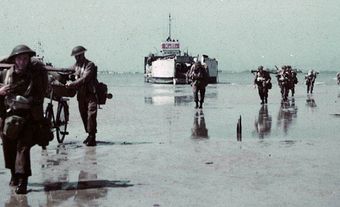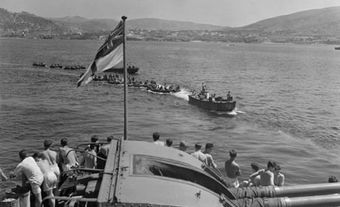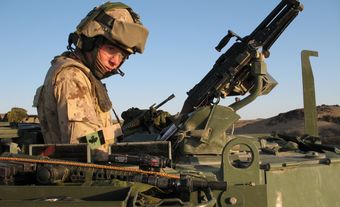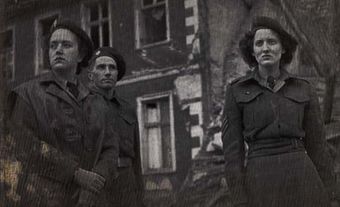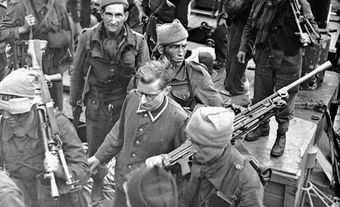The Canadian Army Meteorological Group (CAMG) was a Second World War unit that provided meteorological data to artillery units. The CAMG was involved in key campaigns during the war in Italy and Northwest Europe. Meteorological information helped improve the accuracy of artillery fire, contributing to Allied victory in the war.

Meteorology and Artillery
The accuracy of Canadian artillery units improved during the war due to several factors, including improved communications, range-finding and carefully calibrated guns. Another key factor was the provision of accurate meteorological data. Due to the altitude at which artillery shells travelled, accuracy could be impacted by upper winds and changes in air density. By providing up-to-date information, meteorological teams increased the accuracy of indirect fire. Army meteorology also had a second purpose: to predict surface winds and help plan for the use of smoke screens and chemical warfare.
Army meteorology used pilot weather balloons and theodolites to measure upper winds. The balloons were filled with hydrogen, which required the stockpiling and provision of gas in the field throughout the war. A meteorological report during the war eventually became known as a meteor. The meteorological sections also required communication support in the form of wireless telegraph operators to receive weather data from other stations.

Establishment of Canadian Army Meteorological Section
Upon its initial deployment to England in 1939, 1st Canadian Infantry Division was part of VII British Corps; as such, it was supported with British meteorological data. When the Canadian Corps was formed, a meteorological section was initially attached from the Royal Air Force (RAF). However, in late 1940 the RAF expanded rapidly with the build-up of Bomber and Coastal Commands, and British personnel were required to support their own operations. As there weren’t any trained RCAF personnel available, the Canadian Corps decided to staff the Meteorological Section with Canadian army personnel trained by British experts from the RAF.
On 1 November 1941, a Corps Meteorological Section was stood up with personnel who had spent the summer training with British forces. The unit was designated No.1 Canadian Corps Meteorological Section, Royal Canadian Artillery. One British officer remained with the unit to provide technical knowledge and lead the unit until it had gained enough experience. Command of the section was passed to a Canadian officer on 25 September 1942. Despite Canadian leadership, the technical authority for meteorological matters throughout the war remained the Meteorological Office at the British Air Ministry in London.

Canadian Army Meteorological Group
In October 1943, the unit was expanded and reorganized. The new Canadian Army Meteorological Group (CAMG) had a separate headquarters in the UK, which continued to train meteorological personnel. Several subordinate meteorological sections were assigned to divisional and corps headquarters within I Canadian Corps in Italy. These sections followed I Canadian Corps through Italy and participated in many campaigns, including the assaults on the Hitler, Gustav, and Gothic Lines.
Early in 1944, more meteorological sections were created to support II Canadian Corps in the invasion of Northwest Europe. The only unit of the CAMG to land at Normandy on D-Day was 14 Meteorological Section. They were scheduled to land six hours after the initial assault, in early afternoon. The tide was against them at this point, and the landing ship ran aground on a sand bar. As they were only 180 metres from the shore, a Rhino ferry, a large barge constructed of pontoons, was sent to rescue the soldiers on the landing craft. As the ferry was approaching around midnight it took a direct hit from a German fighter. The troops on that landing craft spent two full nights on the sand bar before they made it ashore. On June 8, when they finally made it ashore, they rejoined their unit, 3rd Canadian Division Headquarters.
On 14 August 1944, No. 18 Meteorological Section was attached to No. 2 Army Group, Royal Canadian Artillery (AGRA) as the offensive carried on through France. RAF bombers mistook 2 AGRA HQ for a German position, and they suffered a friendly fire incident. Three members of No. 18 Meteorological Section were killed in the accident: Bombardiers Harold Brown and Douglas Laird and Gunner Gordon Hubley. The officer commanding, Captain Scott, was wounded and subsequently evacuated to England. It was the largest loss of life for the CAMG during the war.
In early 1945, the meteorological sections were part of Operation Gold Flake. This secret operation involved the movement of I Canadian Corps and other Allied units from the Italian theatre to France. For the first time, all the sections of the CAMG were concentrated in the same theatre of operations. Together, they provided important support to Canadian and Allied units in the final push against Nazi Germany.
When peace was declared in Europe, the focus of CAMG’s work shifted from upper winds to aviation forecasts to support the occupation force. The CAMG was disbanded on 8 August 1945.

 Share on Facebook
Share on Facebook Share on X
Share on X Share by Email
Share by Email Share on Google Classroom
Share on Google Classroom

